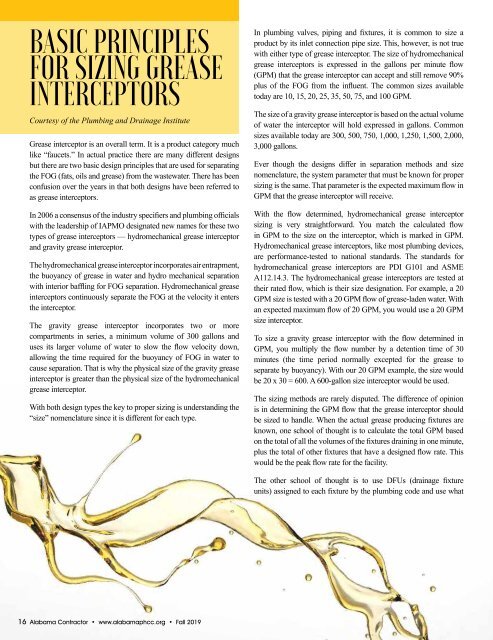Alabama Contractor Fall 2019
You also want an ePaper? Increase the reach of your titles
YUMPU automatically turns print PDFs into web optimized ePapers that Google loves.
BASIC PRINCIPLES<br />
FOR SIZING GREASE<br />
INTERCEPTORS<br />
Courtesy of the Plumbing and Drainage Institute<br />
Grease interceptor is an overall term. It is a product category much<br />
like “faucets.” In actual practice there are many different designs<br />
but there are two basic design principles that are used for separating<br />
the FOG (fats, oils and grease) from the wastewater. There has been<br />
confusion over the years in that both designs have been referred to<br />
as grease interceptors.<br />
In 2006 a consensus of the industry specifiers and plumbing officials<br />
with the leadership of IAPMO designated new names for these two<br />
types of grease interceptors — hydromechanical grease interceptor<br />
and gravity grease interceptor.<br />
The hydromechanical grease interceptor incorporates air entrapment,<br />
the buoyancy of grease in water and hydro mechanical separation<br />
with interior baffling for FOG separation. Hydromechanical grease<br />
interceptors continuously separate the FOG at the velocity it enters<br />
the interceptor.<br />
The gravity grease interceptor incorporates two or more<br />
compartments in series, a minimum volume of 300 gallons and<br />
uses its larger volume of water to slow the flow velocity down,<br />
allowing the time required for the buoyancy of FOG in water to<br />
cause separation. That is why the physical size of the gravity grease<br />
interceptor is greater than the physical size of the hydromechanical<br />
grease interceptor.<br />
With both design types the key to proper sizing is understanding the<br />
“size” nomenclature since it is different for each type.<br />
In plumbing valves, piping and fixtures, it is common to size a<br />
product by its inlet connection pipe size. This, however, is not true<br />
with either type of grease interceptor. The size of hydromechanical<br />
grease interceptors is expressed in the gallons per minute flow<br />
(GPM) that the grease interceptor can accept and still remove 90%<br />
plus of the FOG from the influent. The common sizes available<br />
today are 10, 15, 20, 25, 35, 50, 75, and 100 GPM.<br />
The size of a gravity grease interceptor is based on the actual volume<br />
of water the interceptor will hold expressed in gallons. Common<br />
sizes available today are 300, 500, 750, 1,000, 1,250, 1,500, 2,000,<br />
3,000 gallons.<br />
Ever though the designs differ in separation methods and size<br />
nomenclature, the system parameter that must be known for proper<br />
sizing is the same. That parameter is the expected maximum flow in<br />
GPM that the grease interceptor will receive.<br />
With the flow determined, hydromechanical grease interceptor<br />
sizing is very straightforward. You match the calculated flow<br />
in GPM to the size on the interceptor, which is marked in GPM.<br />
Hydromechanical grease interceptors, like most plumbing devices,<br />
are performance-tested to national standards. The standards for<br />
hydromechanical grease interceptors are PDI G101 and ASME<br />
A112.14.3. The hydromechanical grease interceptors are tested at<br />
their rated flow, which is their size designation. For example, a 20<br />
GPM size is tested with a 20 GPM flow of grease-laden water. With<br />
an expected maximum flow of 20 GPM, you would use a 20 GPM<br />
size interceptor.<br />
To size a gravity grease interceptor with the flow determined in<br />
GPM, you multiply the flow number by a detention time of 30<br />
minutes (the time period normally excepted for the grease to<br />
separate by buoyancy). With our 20 GPM example, the size would<br />
be 20 x 30 = 600. A 600-gallon size interceptor would be used.<br />
The sizing methods are rarely disputed. The difference of opinion<br />
is in determining the GPM flow that the grease interceptor should<br />
be sized to handle. When the actual grease producing fixtures are<br />
known, one school of thought is to calculate the total GPM based<br />
on the total of all the volumes of the fixtures draining in one minute,<br />
plus the total of other fixtures that have a designed flow rate. This<br />
would be the peak flow rate for the facility.<br />
The other school of thought is to use DFUs (drainage fixture<br />
units) assigned to each fixture by the plumbing code and use what<br />
16 <strong>Alabama</strong> <strong>Contractor</strong> • www.alabamaphcc.org • <strong>Fall</strong> <strong>2019</strong>


















